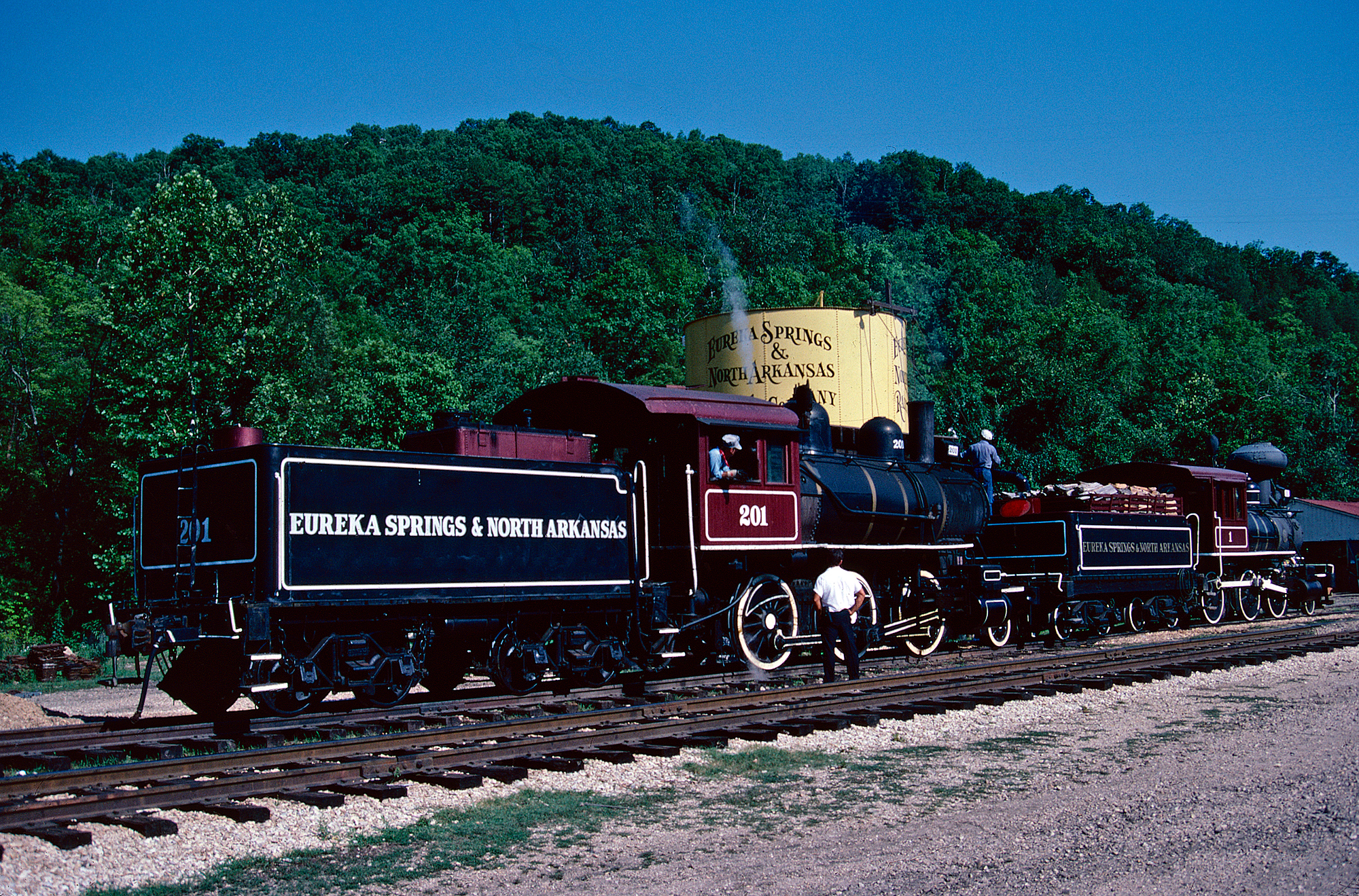EMD "E9" Locomotives: Specs, Roster, History
Last revised: December 16, 2024
By: Adam Burns
The E9 was Electro-Motive's final streamlined locomotive featuring the classic "bulldog nose" design. In his book, "Diesel Locomotives: Cyclopedia, Volume 2," author Bob Hayden notes the E8 and E9 were practically identical externally, save for a minor difference in the headlight.
However, internally, the E9 was equipped with EMD's latest version of the 567 which featured a number of improvements over earlier variants. These upgrades made it the most reliable power plant up until that time, and the E9 the finest passenger locomotive of the series. The model also boasted other upgrades, which will be mentioned in greater detail below.
Despite these enhancements, and the E9's greater horsepower, the model sold only 153 examples, far fewer than either the E7 or E8. The reason was entirely market related and had nothing to do with the locomotive's performance.
In his book, "Electro-Motive E-Units and F-Units: The Illustrated History of North America's Favorite Locomotives," author Brian Solomon notes the public's growing disinterest in rail travel, coupled with most railroads having already dieselized their top passenger trains by that time, was the reason behind the lower sales. Today, several E9s are preserved; the most famous are the units still leading Union Pacific's business train.
Photos
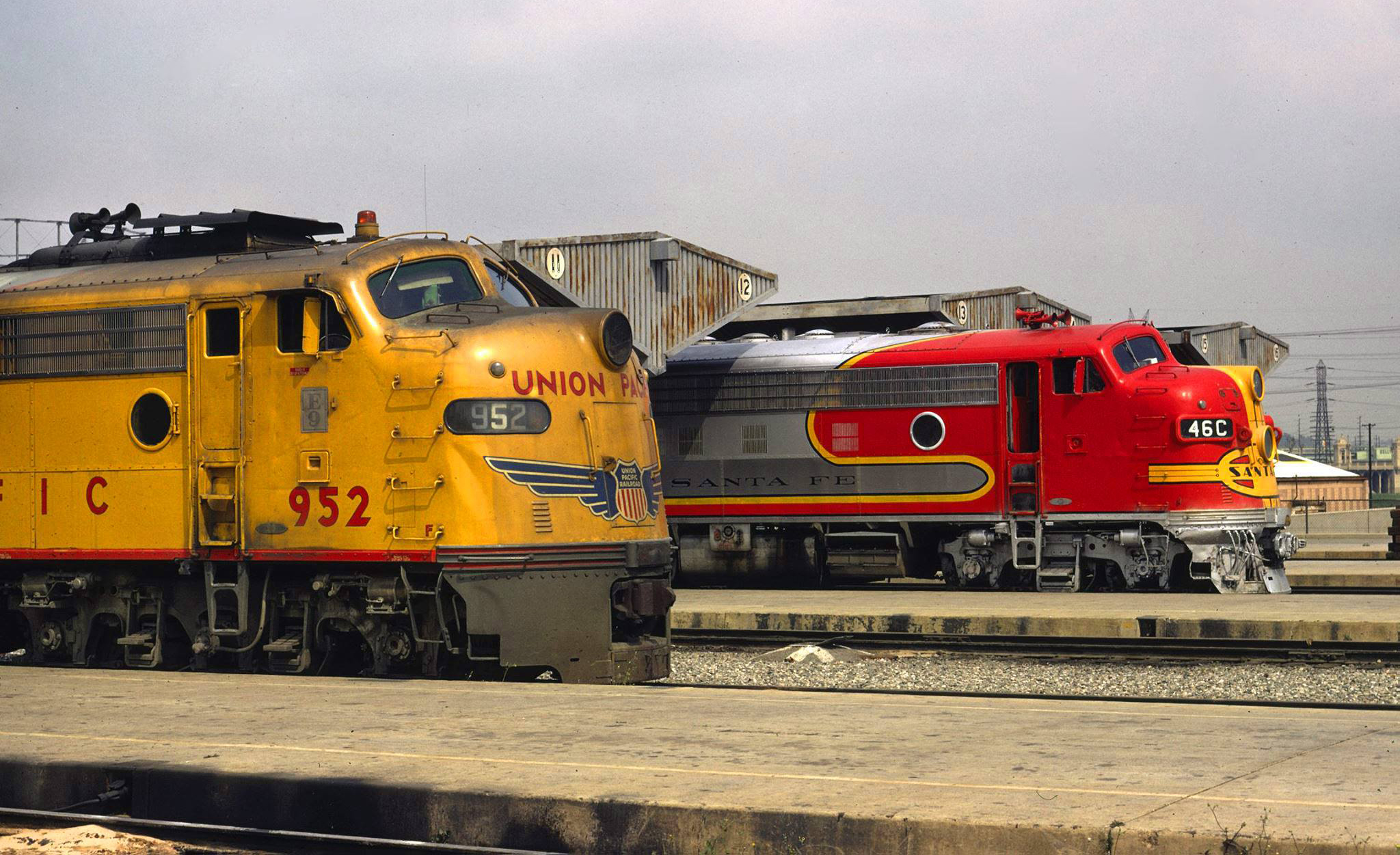 Union Pacific E9A #952 has just arrived at Los Angeles Union Passenger Terminal with the westbound 'City of Los Angeles' while Santa Fe F7A #46-C awaits departure from Track #12 with a regional 'San Diegan' during March of 1971. Drew Jacksich photo.
Union Pacific E9A #952 has just arrived at Los Angeles Union Passenger Terminal with the westbound 'City of Los Angeles' while Santa Fe F7A #46-C awaits departure from Track #12 with a regional 'San Diegan' during March of 1971. Drew Jacksich photo.History
In many ways the E8 was EMD's preeminent passenger locomotive. It enjoyed nearly the highest sales of any "E" model (slightly eclipsed by the earlier E7) and was a fixture leading trains from the 1950s, through the early Amtrak era.
However, the E9 was the builder's most technologically advanced, incorporating nearly 20 years of improvements into the series. Both the E8 and E9 enjoyed years of service, with some even continuing in commuter assignments into the 1980s and 1990s.
The E9 began production in the spring of 1954 as the builder's final entry in a series that spanned ten different models dating back to Electro-Motive Corporation's EA and E1 of 1937/1938, built for the Baltimore & Ohio and Santa Fe.
The model was quite similar to the earlier E8 externally. Author Gerald Foster points out in his book, "A Field Guide To Trains," the only visual difference was the headlight glass, which was recessed on the E8 but flush on the E9.
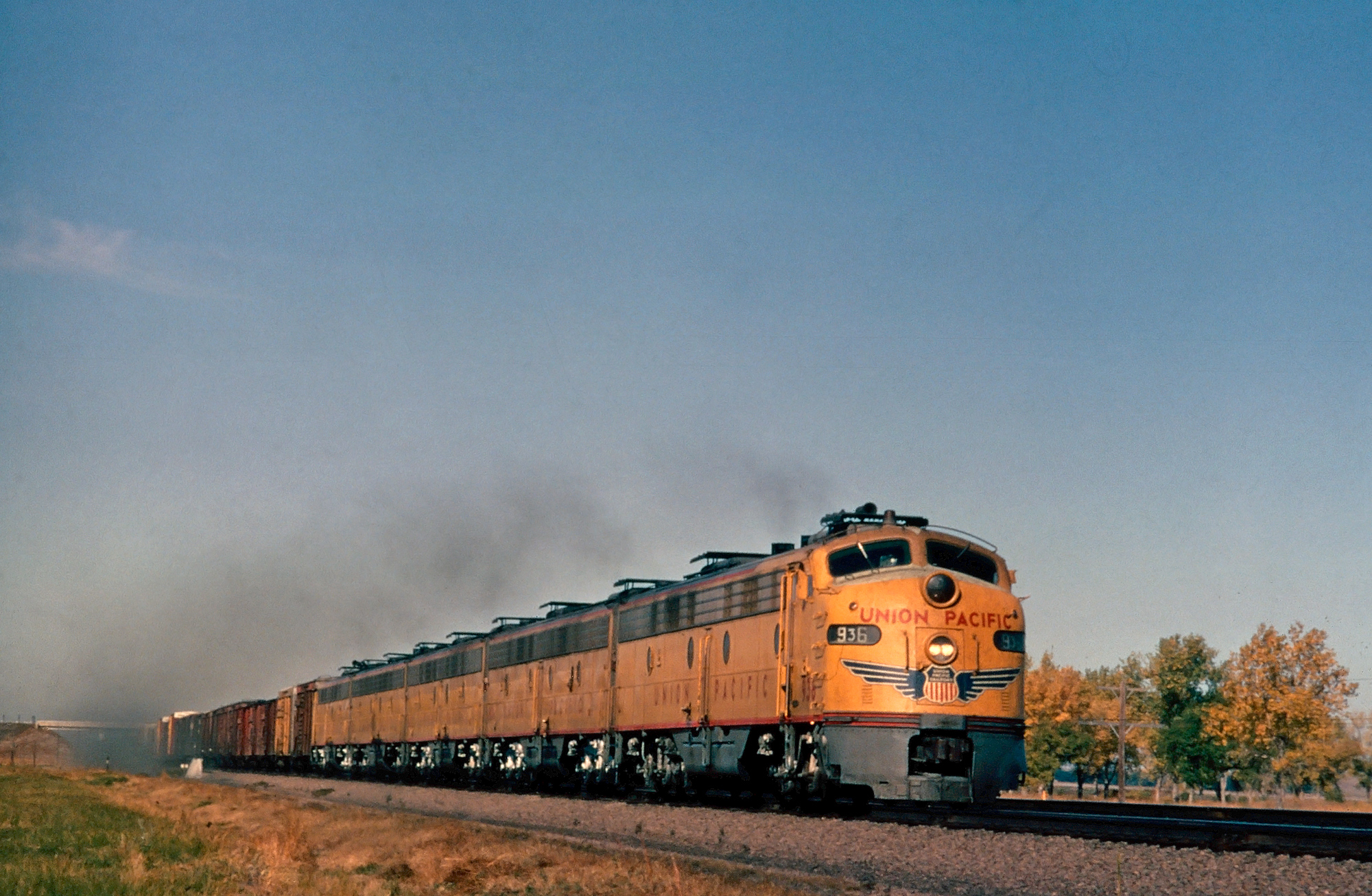 Union Pacific E9's in freight service during the late 1960s. Location not listed. American-Rails.com collection.
Union Pacific E9's in freight service during the late 1960s. Location not listed. American-Rails.com collection.It was under hood where the two models differed significantly. The E9 was part of EMD's "9 Line" (E9, GP9, SD9, F9, and FP9), equipped with the manufacturer's latest 567 variant, the model 567C, which boasted a number of improvements over the earlier 567B.
Featuring a pair of 12-cylinder engines, the E9 offered an impressive 2,400 horsepower, an increase of 150 horsepower over the earlier E8. Mr. Solomon goes on to note the 567C's crankcase could be easily differentiated from earlier versions by its round hand-hole covers in place of the rectangular design.
The 567C also sported an improved cooling circuit which virtually eliminated water leaks within the system. In fact, this improved design worked so well EMD even offered older engines the option of being rebuilt, which slightly modified their prefix as a 567AC or 567BC.
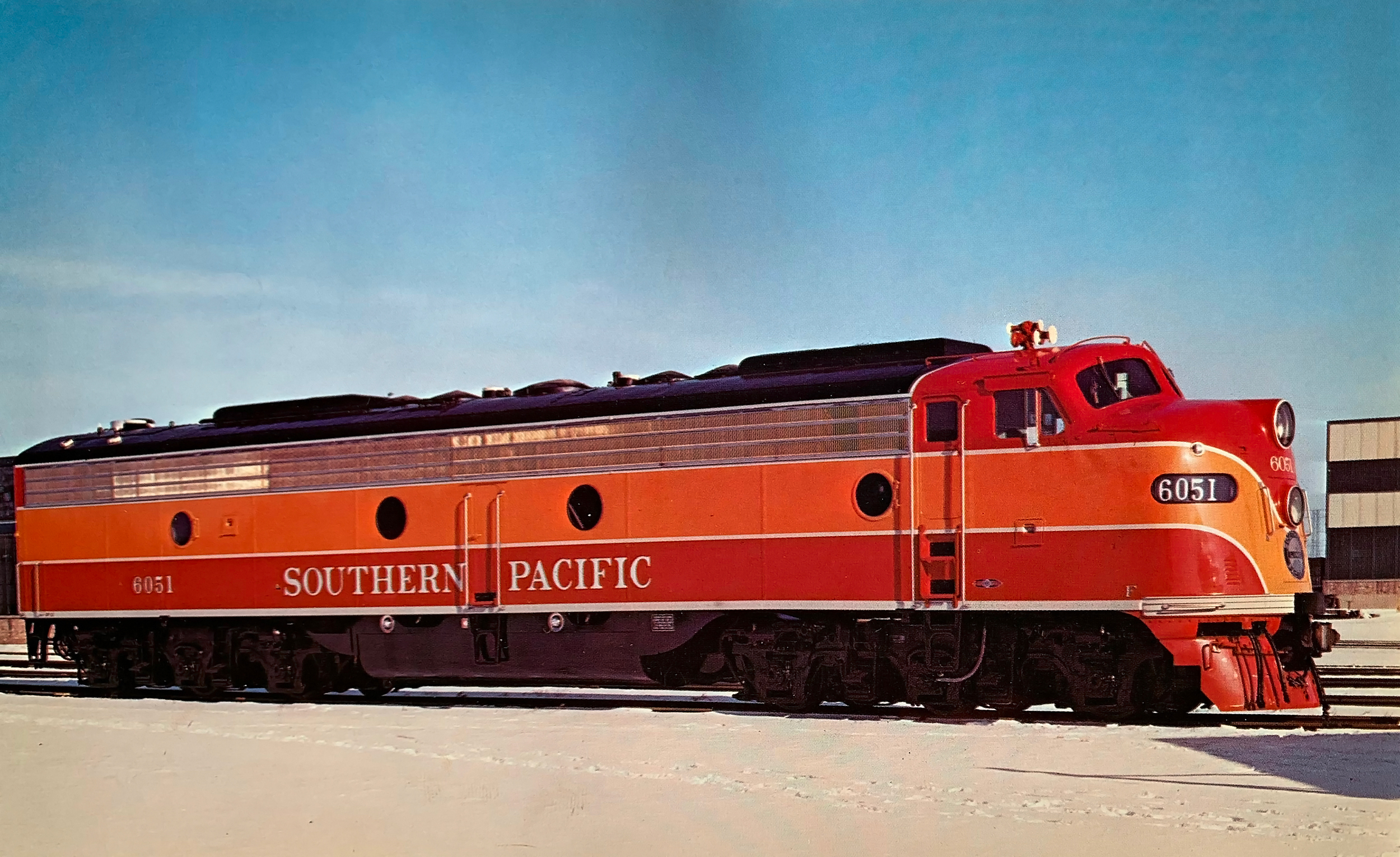 An Electro-Motive photo featuring recently completed Southern Pacific E9A #6051 in December, 1954. Today, this unit is preserved and operational in her "Daylight" livery at the California State Railroad Museum.
An Electro-Motive photo featuring recently completed Southern Pacific E9A #6051 in December, 1954. Today, this unit is preserved and operational in her "Daylight" livery at the California State Railroad Museum.By the time the E9 was introduced the industry's interest in passenger trains was waning. The hope of continued postwar prosperity had not occurred; coupled with the completion of dieselization for most railroads by the mid 1950s, E9s saw roughly a third of sales in comparison to the earlier E8 and E7.
In the end, just nine different companies purchased the model which included Union Pacific; Seaboard Air Line; Illinois Central; Milwaukee Road; Kansas City Southern (which owned a single example, an EMD rebuild of an E6A); Chicago & Eastern Illinois; Chicago, Burlington & Quincy; Baltimore & Ohio; and Florida East Coast.
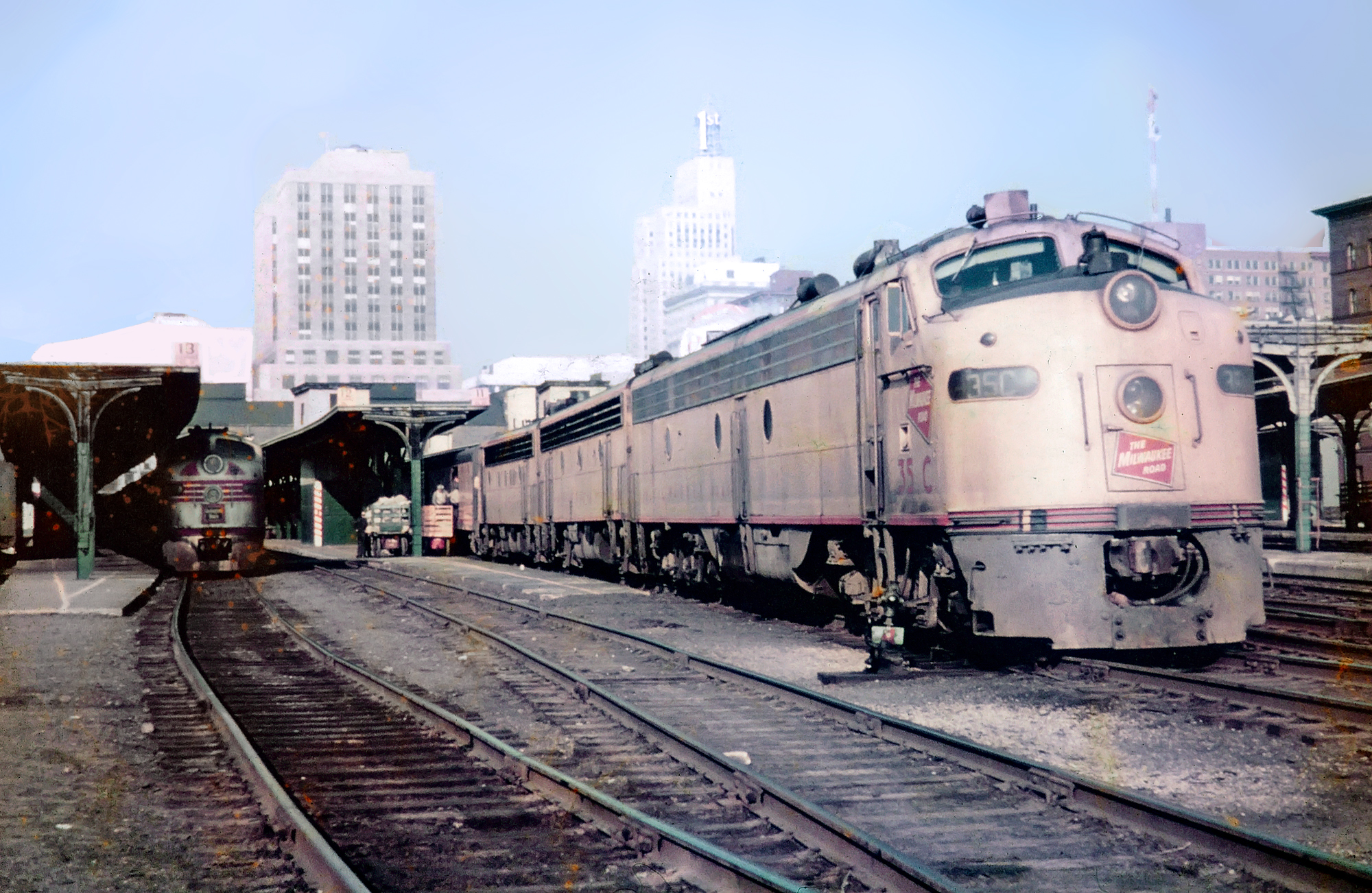 Milwaukee Road E9A #35-C awaits departure from St. Paul Union Depot with an eastbound "Hiawatha" in May, 1968. Fred Byerly photo. American-Rails.com collection.
Milwaukee Road E9A #35-C awaits departure from St. Paul Union Depot with an eastbound "Hiawatha" in May, 1968. Fred Byerly photo. American-Rails.com collection.Data Sheet and Specifications
| Entered Production | 4/1954 (Illinois Central #4034) |
| Years Produced | 4/1954 - 1/1964 |
| Engine | 567C (2) |
| Engine Builder | GM |
| Horsepower | 2400 |
| RPM | 835 |
| Cylinders | 12 |
| Length (E9A) | 70' 3" |
| Length (E9B) | 70' 0" |
| Height (Top Of Rail To Top Of Cab) | 14' 10 ½" (E9A) |
| Height (Top Of Rail To Top Of Cab) | 14' 7 ½" (E9B) |
| Width | 10' 7 ½" |
| Weight | 316,500 Lbs (A Units): 308,300 Lbs (B Units) |
| Fuel Capacity | 1,200 Gallons |
| Air Compressor | Gardner-Denver |
| Air Compressor Model | WXO |
| Air Brake Manufacturer | Westinghouse |
| Air Brake Schedule | 24RL |
| Trucks | A1A |
| Truck Type | Blomberg |
| Truck Wheelbase | 14' 1" |
| Wheel Size | 36" |
| Steam Generator Manufacturer | Vapor-Clarkson |
| Steam Generator Capacity | 1200 Lbs/Hr |
| Traction Motors | D37 (4), GM |
| MU (Multiple-Unit) | Yes |
| Dynamic Brakes | Yes (A Units) |
| Gear Ratio | 52:25, 55:21, 56:21, 57:20 |
| Tractive Effort (Starting) | 56,500 Lbs at 25% |
| Tractive Effort (Continuous) | 19,500 (52:25); 23,500 (55:21); 25,000 (56:21); 27,000 Lbs (57:20) |
| Top Speed | 117 mph (52:25), 98 mph (55:21), 92 mph (56:21), 85 mph (57:20) |
Production Rosters
E9A
Total Built = 101
| Owner | Road Number | Serial Number | Order Number | Completion Date |
|---|---|---|---|---|
| Illinois Central | 4034-4035 | 18787-18788 | 2062 | 4/1954 |
| Union Pacific | 943-947 | 19281-19285 | 2058 | 5/1954 - 6/1954 |
| Pennsylvania | 5805 (2nd)* | 15669 | 2062A | 6/1954 |
| Illinois Central | 4036* | 19608 | 7517 | 6/1954 |
| Chicago, Burlington & Quincy | 9990-9995 | 19629-19634 | 2065 | 6/1954, 8/1954 |
| Florida East Coast | 1031-1035 | 20083-20087 | 2067 | 1/1955 |
| Southern Pacific | 6046-6054 | 20095-20103 | 2068 | 12/1954 |
| Baltimore & Ohio | 34-40 (Evens) | 20377-20380 | 2069 | 5/1955 |
| Union Pacific | 948-956 | 20485-20493 | 2070 | 5/1955 - 10/1955 |
| Union Pacific | 957-962 | 20494-20499 | 2072 | 9/1955 - 11/1955 |
| Chicago, Burlington & Quincy | 9985A, 9985B - 9989A, 9989B | 20533-20542 | 2071 | 12/1955 - 1/1956 |
| Union Pacific | 900-902 | 21261-21263 | 7527 | 5/1956 |
| Union Pacific | 903-906 | 21264-21267 | 7527 | 1/1956 - 2/1956 |
| Union Pacific | 907 | 21268 | 7527 | 6/1956 |
| Milwaukee Road | 200A, 200C - 205A, 205C | 21601-21612 | 2075 | 4/1956 - 5/1956 |
| Illinois Central | 4037-4038 | 21819-21820 | 7528 | 1/1956, 5/1956 |
| Illinois Central | 4039-4040 | 22592-22593 | 7/1956, 2/1957 | 7532 |
| Illinois Central | 4041 | 23190 | 7547 | 5/1957 |
| Illinois Central | 4042 | 23193 | 7547 | 12/1957 |
| Chicago & Eastern Illinois | 1102 | 24733 | 7565 | 8/1958 |
| Kansas City Southern | 25** | 25355 | 8061 | 6/1959 |
| Milwaukee Road | 36A, 36C - 38A, 38C | 26565-26570 | 7596 | 4/1961 |
| Union Pacific | 908-909 | 26672-26673 | 7604 | 8/1961 |
| Illinois Central | 4043 | 26654 | 7600 | 5/1961 |
| Union Pacific | 910-911 | 27694-27695 | 7629 | 12/1962 |
| Seaboard Air Line | 3060 | 28524 | 7667 | 10/1963 |
| Union Pacific | 912-914 | 28667-28669 | 7689 | 12/1963 - 1/1964 |
* Documentation on this locomotive is very hazy. This is the second 5805 the PRR acquired in June, 1954 after E8A #5805 was destroyed in a collision at Chicago Union Station on March 10, 1954. The second 5805 was originally to be part of a two-unit order for Illinois Central, which the railroad would later cancel. This order would have been a continuation of order 2062 with serials 19371-19372.
Interestingly, IC went on to trade-in wrecked E6A #4004 for one of the locomotives, which became IC #4036 on order 7517 (serial 19608). The PRR acquired the other unit to replace destroyed E8A #5805. It is said EMD derated the the second 5805's 567C prime mover to 2,250 horsepower (like an E8A) and also used some of the first 5805's electrical gear and main generator. In addition, for legal and insurance purposes, the second 5805 used the first 5805's serial number.
** Built as E6A #5 (serial 1432) in January, 1942. Rebuilt by EMD to E9 specifications in June, 1959.
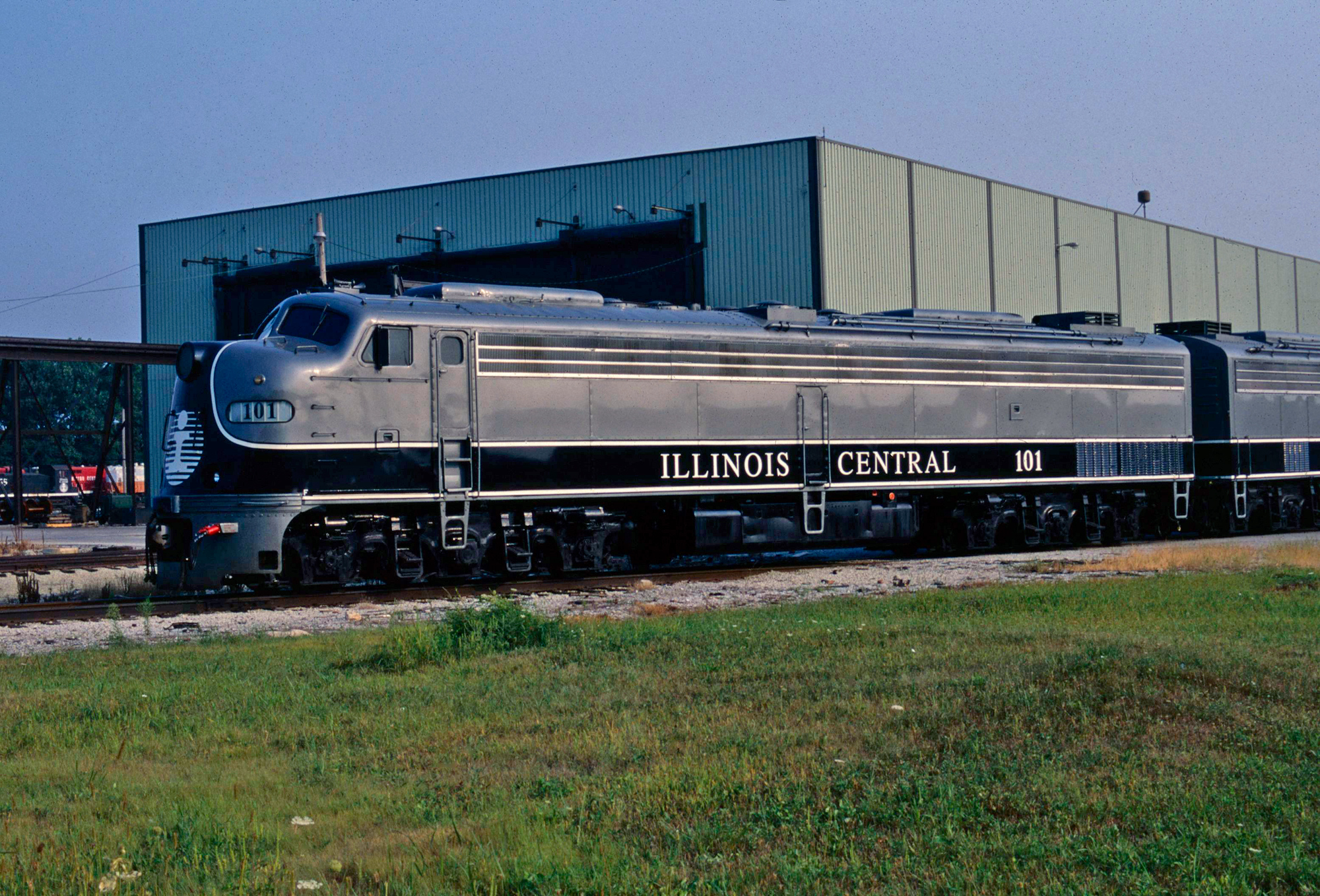 Illinois Central's pair of "Executive" E9As, #101 and #100, layover at the Woodcrest Shops in Homewood, Illinois on August 31, 1996. These units were built as Chicago, Burlington & Quincy E8A's #9977 and #9938A. Photographer unknown. American-Rails.com collection.
Illinois Central's pair of "Executive" E9As, #101 and #100, layover at the Woodcrest Shops in Homewood, Illinois on August 31, 1996. These units were built as Chicago, Burlington & Quincy E8A's #9977 and #9938A. Photographer unknown. American-Rails.com collection.E9B
Total Built = 52
| Owner | Road Number | Serial Number | Order Number | Completion Date |
|---|---|---|---|---|
| Union Pacific | 950B-959B | 19286-19295 | 2058 | 5/1954 - 6/1954 |
| Union Pacific | 960B-966B | 20500-20514 | 2070 | 5/1955 - 7/1955 |
| Union Pacific | 967B-974B | 20507-20514 | 2072 | 9/1955 - 10/1955 |
| Union Pacific | 900B-904B | 21269-21273 | 7527 | 1/1956 - 2/1956 |
| Milwaukee Road | 200B-205B | 21613-21618 | 2075 | 2/1956 - 4/1956 |
| Illinois Central | 4106-4107 | 22594-22595 | 7532 | 9/1956, 11/1956 |
| Illinois Central | 4108-4109 | 23191-23192 | 7547 | 7/1957, 10/1957 |
| Union Pacific | 910B-911B | 27696-27697 | 7629 | 12/1962 |
| Union Pacific | 912B-913B | 28670-28671 | 7689 | 11/1963 - 12/1963 |
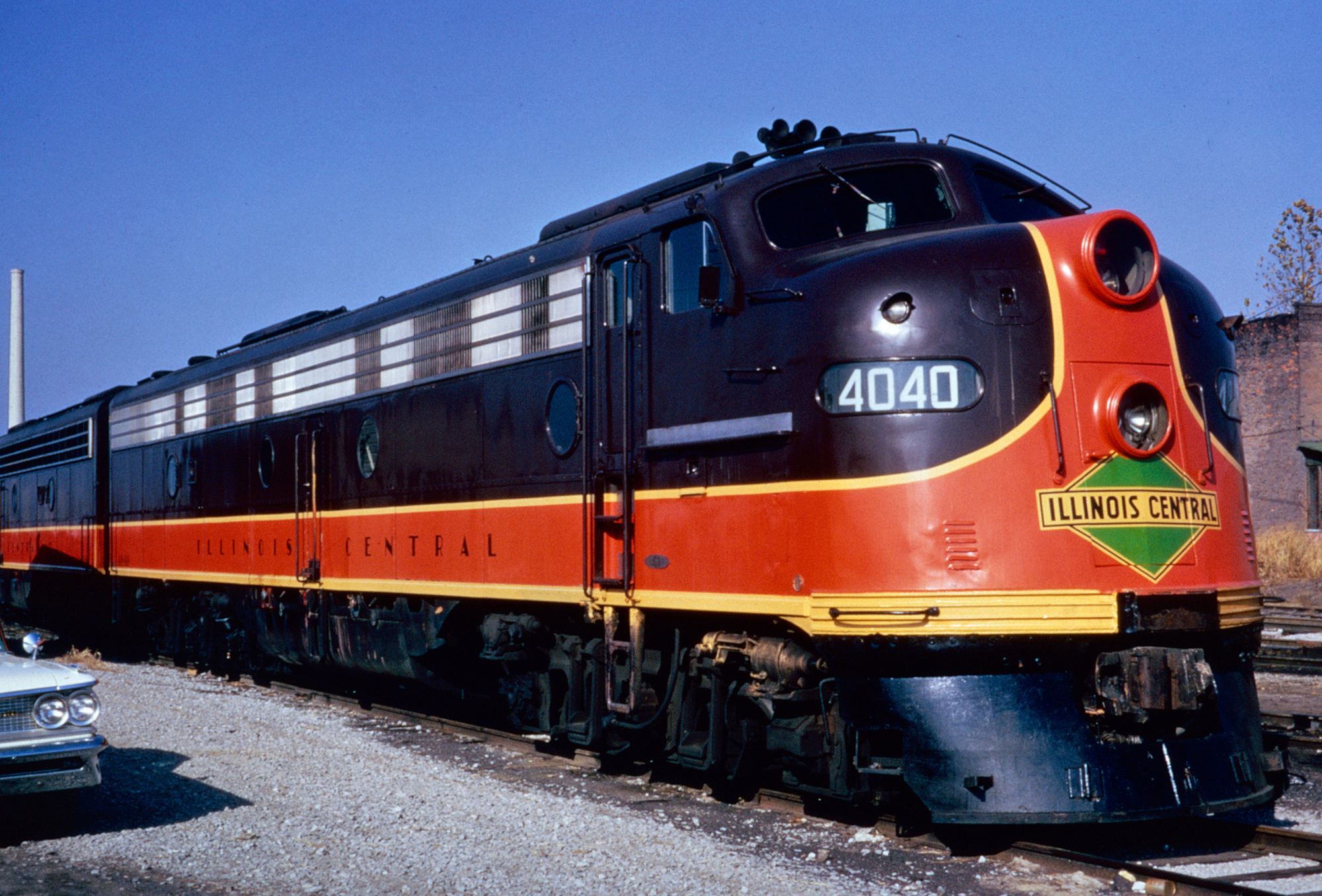 Illinois Central E9A #4040 is tied down at South Yard in Memphis, Tennessee on November 13, 1966. American-Rails.com collection.
Illinois Central E9A #4040 is tied down at South Yard in Memphis, Tennessee on November 13, 1966. American-Rails.com collection.The E9 also marked the end of EMD's classic streamlined passenger locomotive series. Future models either featured the builder's cowl carbody, such as the FP45, or were dual-service road-switchers like the SDP35, SDP40, and SDP45.
Today, several E9s are preserved around the country, some of which are still operational. The most famous are Union Pacific's E9s, a few of which the railroad maintains as part of its heritage program. These include E9A's #949 and #951 along with E9B #963-B.
The locomotives, however, have been heavily modernized internally, following a 1993 rebuild program. They no longer feature their 567C prime movers; instead, the units sport a single 16-cylinder, 645E power plant (which can produce 2,000 horsepower).
Historical Perception
The "E" series has long been regarded as the finest passenger locomotives ever built. It's hard to argue this point given their success, reliability, and good looks. However, not every railroad was sold, especially western lines like the Santa Fe, which viewed the Es as lacking the needed traction to handle trains over the stiff grades of Raton Pass, Cajon Pass, and Tehachapi.
After acquiring the early E1, the railroad purchased no further models in the series (although it did have its E1s rebuilt by EMD to E8 specs). Instead, it acquired large batches of the sure-footed F3 and F7 to handle its top trains to and from Chicago.
The Southern Pacific echoed the AT&SF sentiments and viewed the E7 as a "frail device." It instead preferred Alco's PA, which boasted greater tractive effort and dynamic brakes (a feature which EMD did not offer until the E8's introduction), for passenger assignments.
The SP's remarks are surprising, given EMD's impeccable reputation at the time, but did not go unnoticed by the industry. As Mr. Solomon points out, in the 1940s and 1950s, the railroad was one of the largest and finest in the nation. Interestingly, as seen with the E9, SP did return to EMD, acquiring nine examples of the model.
Sources
- Foster, Gerald. A Field Guide To Trains. New York: Houghton Mifflin, 1996.
- Hayden, Bob. Diesel Locomotives: Cyclopedia, Volume 2 (Model Railroader). Milwaukee: Kalmbach Publishing Company, 1980.
- Marre, Louis A. Diesel Locomotives: The First 50 Years, A Guide To Diesels Built Before 1972. Milwaukee: Kalmbach Publishing Company, 1995.
- Pinkepank, Jerry A. Diesel Spotter's Guide. Milwaukee: Kalmbach Publishing Company, 1967.
- Solomon, Brian. EMD Locomotives. Minneapolis: MBI Publishing Company, 2006.
- Solomon, Brian. Electro-Motive E-Units and F-Units: The Illustrated History of North America's Favorite Locomotives. Minneapolis: Voyageur Press, 2011.
Contents
Recent Articles
-
Arizona Railroad Museums: A Complete Guide
Apr 16, 25 01:17 PM
Learn about Arizona's rich history with railroads at one of several museums scattered throughout the state. More information about these organizations may be found here. -
Arkansas Railroad Museums: A Complete Guide
Apr 16, 25 12:59 PM
The state of Arkansas is home to a handful of small railroad museums. Learn more about these organizations here. -
Alabama Railroad Museums: A Complete Guide
Apr 16, 25 12:30 PM
Alabama, with its storied past and vibrant connection to the railroad industry, is home to several captivating railroad museums.

